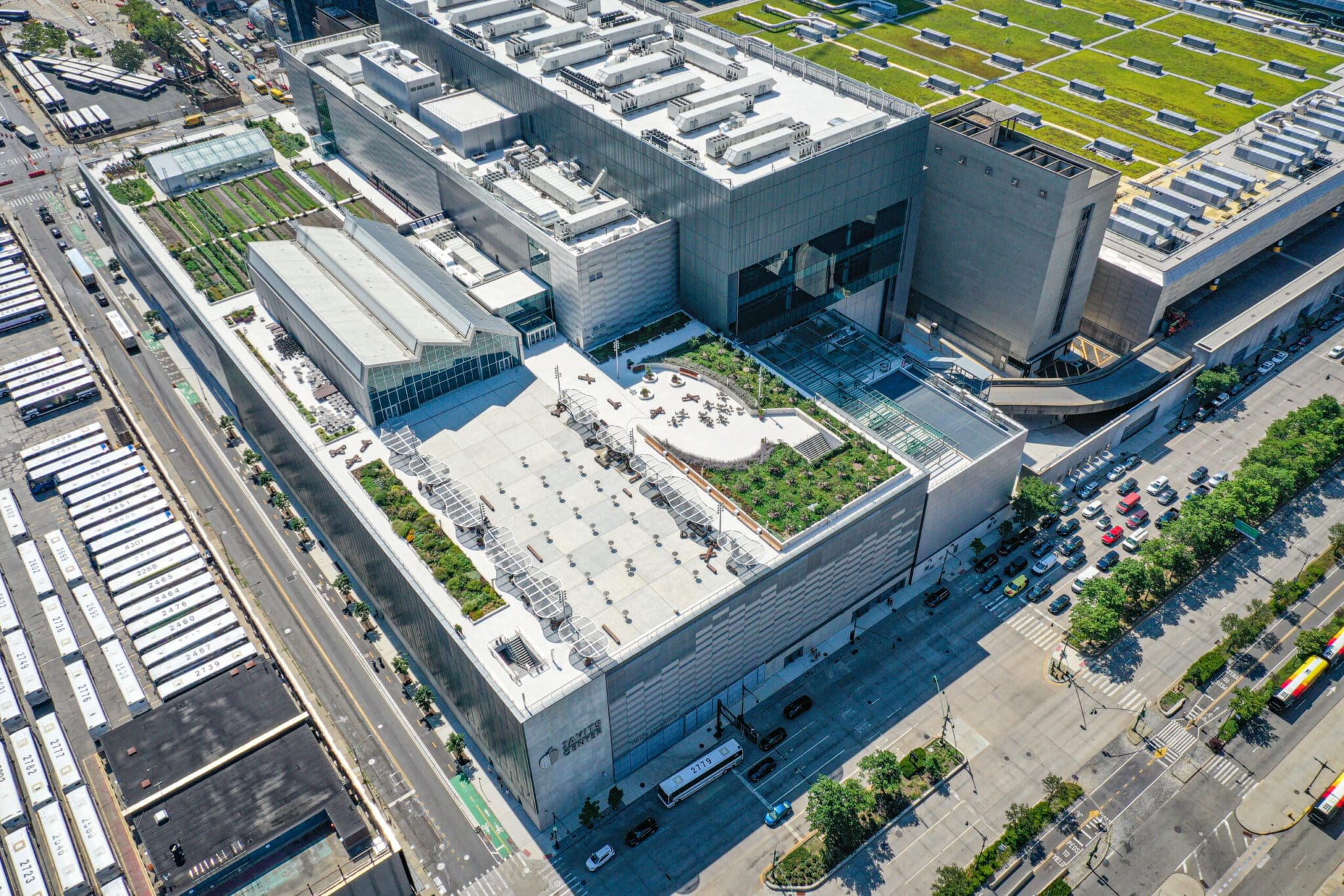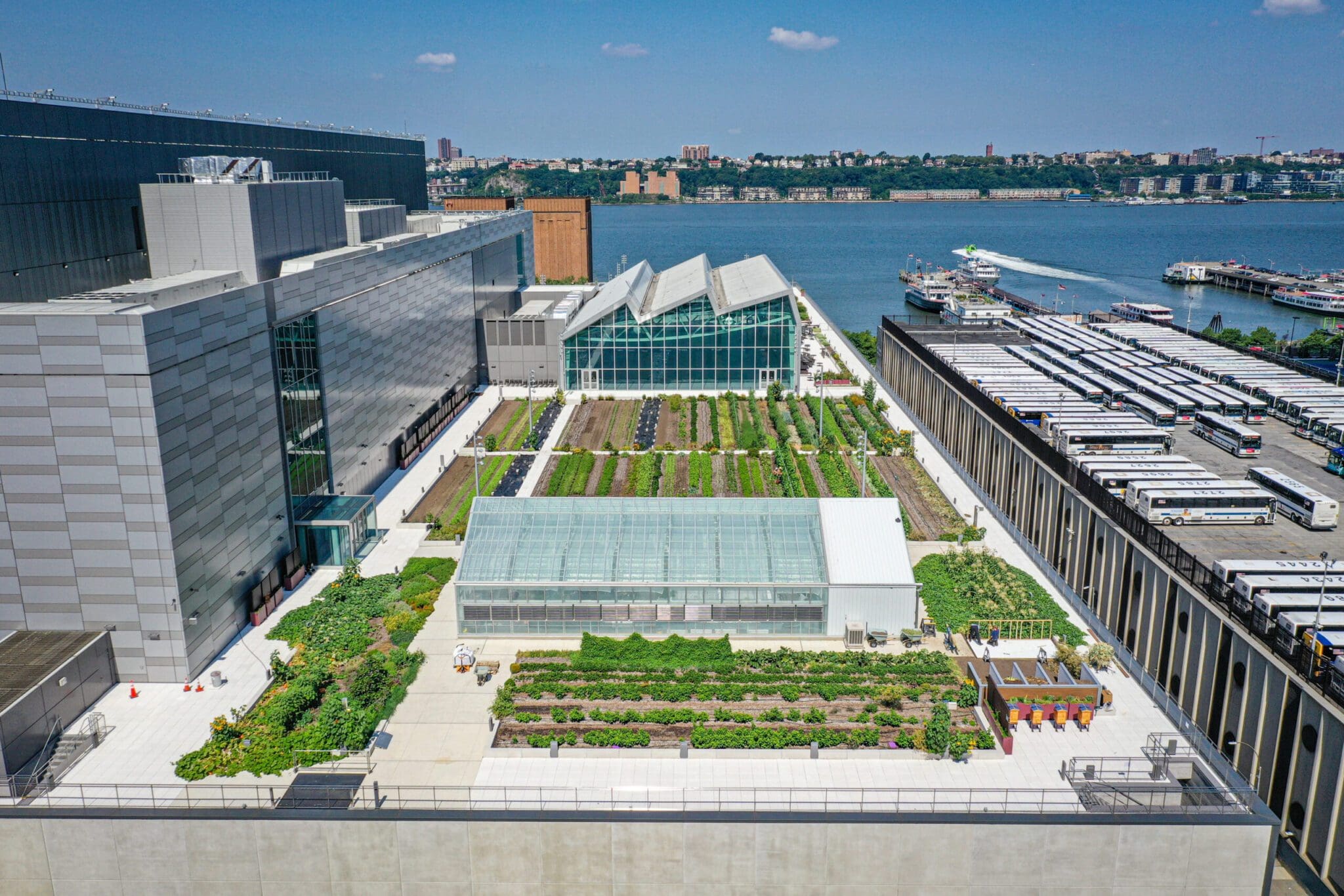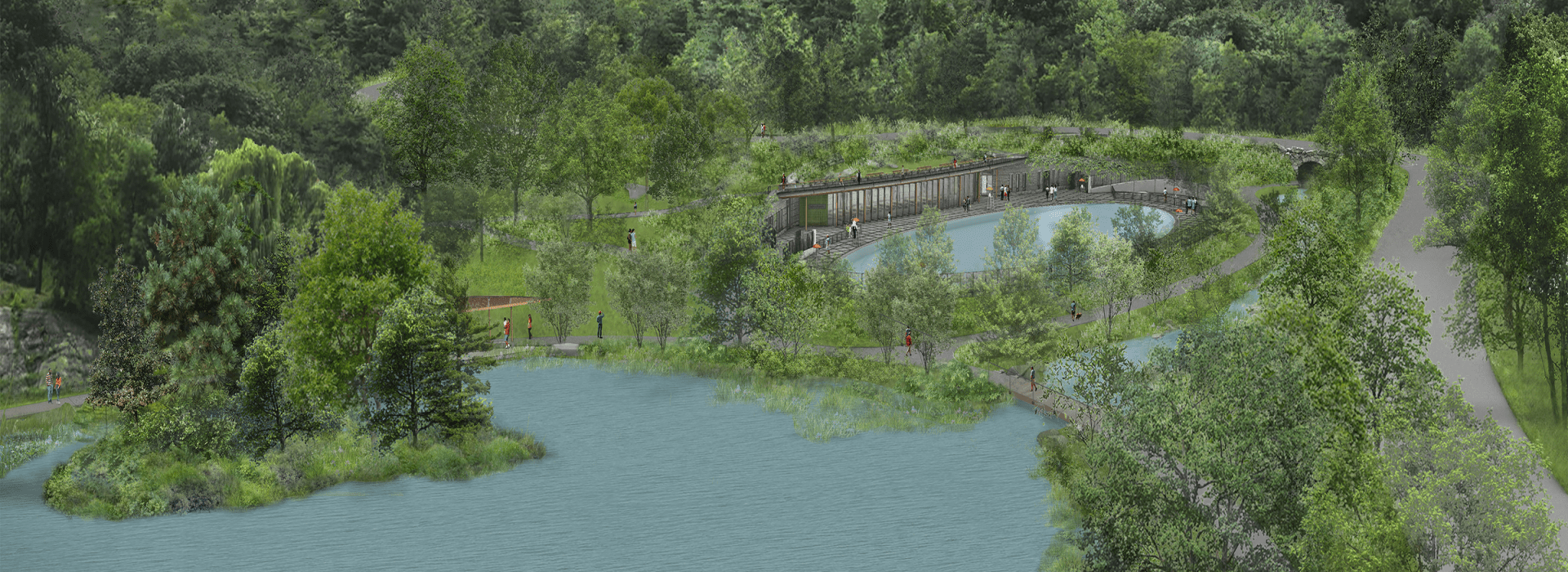Jacob K. Javits Convention Center Expansion
Adaptive Green began consulting with the Jacob K. Javits Convention Center Expansion builders (Lendlease Turner JV) in 2018.
With a $1.5 billion budget for the Expansion, Adaptive Green implemented a unique combination of green infrastructure leveraging the American hydrotech Intensive Garden Roof Assembly from an operational orchard, urban farm, meadow, permeable pavement, and greywater recycling irrigation systems. Upon completion, the Javits Center is the third-largest green roof in America and boasts the country’s most significant state-funded urban rooftop farm.
Adaptive Green performed the work in accordance with the Project Labor Agreement and New York State’s Minority Business Enterprise requirements.
Project Background
The Jacob K. Javits Convention Center, located in New York City, has established itself as a leading example of sustainable urban development. The center’s recent expansion was completed between 2021 and 2022 and driven by the need to enhance capacity while prioritizing sustainability. A defining feature of this extension is the expansive green roof, which is one of the biggest in the US at an astonishing 6.75 acres. This innovative feature is an essential tool for managing stormwater, efficiently lowering runoff and enhancing the quality of the nearby water systems. By absorbing rainwater, the green roof alleviates pressure on the city’s drainage systems, contributing to enhanced resilience against flooding and other climate-related challenges.
The motivation behind the Javits Center’s expansion was a blend of economic and environmental goals.With sustainability as a primary motivator, the project aimed to significantly reduce the center’s environmental footprint and meet higher standards for green building certifications. This commitment to sustainability aligns with New York City’s initiatives to promote eco-friendly practices and combat climate change.
Many stakeholders were involved in this multifaceted project, each playing a crucial role in its successful completion. Their collaborative efforts ensured the integration of cutting-edge technologies and design principles that optimize the roof’s performance.
Project Scope and Design
The Jacob K. Javits Green Roof Project represents a comprehensive effort to enhance urban sustainability through innovative design and functionality. Covering an impressive 6.75 acres, the green roof was designed to not only provide a vibrant ecosystem but also serve critical purposes such as stormwater management and energy efficiency.
By integrating a robust layered system that includes a waterproof membrane, drainage layer, and carefully selected soil blend, the project effectively captures rainwater, significantly reducing runoff and improving water quality in the surrounding environment. This project enhances local biodiversity by incorporating native plant species, which significantly reduces maintenance requirements, presenting a highly sustainable and efficient solution for urban landscaping.
Environmental Benefits
The Jacob K. Javits Green Roof Project offers numerous environmental benefits that significantly enhance the urban ecosystem and align with New York City’s sustainability objectives. By absorbing rainfall, the green roof decreases the volume of stormwater runoff that enters the city’s sewer system. This not only helps mitigate flooding but also reduces pollutants in surrounding rivers and streams.
In addition to managing stormwater, the green roof plays a crucial role in reducing the urban heat island effect, where cities experience elevated temperatures due to concrete, asphalt, and building structures while lacking green spaces. By incorporating a significant area of vegetation, the Javits Center helps lower ambient temperatures, creating a cooler environment for residents and visitors.
The green roof has developed into a valuable habitat for local wildlife, supporting over 30 bird species and various insects, including honeybees. After the renovation, monitoring by the NYC Bird Alliance’s Project Safe Flight revealed a remarkable 90 percent reduction in bird collisions at the center, underscoring the roof’s positive impact on local wildlife. In 2022, a significant Herring Gull colony flourished on the roof, establishing 150 nests, giving researchers the chance to examine the population.
The vegetation on the green roof systems plays a significant role in improving air quality by filtering out pollutants and producing oxygen. The plants actively absorb carbon dioxide (CO2), particulate matter, and other harmful air pollutants resulting in cleaner air for the surrounding community.
Jacob K. Javits Green Roof Project exemplifies how large-scale urban developments can integrate sustainable practices to achieve substantial environmental benefits. By enhancing stormwater management, improving energy efficiency, fostering biodiversity, and contributing to better air quality, this project serves as a model for future green initiatives in urban settings around the world.
Social and Community Impact
The Jacob K. Javits Green Roof Project not only enhances environmental sustainability but also offers social and community benefits. With its accessible pathways and observation areas, visitors can immerse themselves in the beauty of the plants and wildlife while enjoying breathtaking views of the skyline. The project promotes community involvement and improves the quality of life for both residents and visitors. The Javits Center actively welcomes students from schools, universities, and environmental organizations to explore its facilities, providing valuable insights into sustainable building practices, green infrastructure, biodiversity, and urban agriculture. These educational tours and programs play a role in raising awareness about climate change, urban sustainability, and ecological preservation for students, professionals, and the general public.
Monitoring and Maintenance
The Jacob K. Javits Green Roof Project incorporates a comprehensive monitoring and maintenance plan that is crucial for ensuring its ecological contributions and overall effectiveness. Regular evaluations focus on important factors such as stormwater management, energy efficiency, and biodiversity support. This approach assesses key elements like water retention and runoff, temperature control, and the growth and wellbeing of the plants across the roof. To ensure successful plant health and growth, irrigation systems have been installed to provide water during dry periods or extreme heat. Soil management is also a key aspect of the maintenance plan, as the substrate used in green roofs requires periodic evaluation and care to remain conducive to plant growth.
Wildlife activity, including the monitoring of bird populations and honeybee hive performance, is carefully tracked by researchers to understand the green roof’s influence on local biodiversity. The New York City Audubon Society actively participates in this initiative, particularly regarding bird monitoring. This partnership helps evaluate the roof’s success in enhancing biodiversity and offers valuable insights that can guide future urban green infrastructure initiatives.
Conclusion
- The impact of Adaptive Green’s work i.e., how much food does the urban farm produce, stormwater managed which also equals the greywater recycled, any energy statistics, and use by the convention center / community.
- What this example demonstrates to other public convention spaces, can we design them more holistically for their own users but also the community?
- Does it reduce the impact / cost on the taxpayers (who fund the projects)?
https://www.nytimes.com/2021/04/19/nyregion/jacob-javits-center-expansion.html









